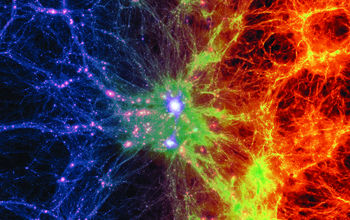All Images
News Release 16-098
NSF awards $110 million to bring advanced cyberinfrastructure to nation’s scientists, engineers
XSEDE 2.0 to provide services and support for advanced computational and data-enabled research at the forefront of science and engineering
This material is available primarily for archival purposes. Telephone numbers or other contact information may be out of date; please see current contact information at media contacts.

An international team of researchers used resources from XSEDE to develop components that would serve as the basis for "Illustris," the most ambitious simulation of galaxy formation ever done. The project is described in a paper published on May 8, 2014, in the journal Nature. Here, a large-scale view of the simulation volume, centered on the most massive galaxy cluster in the simulation at the present cosmic time. Dark matter density is shown in blue and purple, and the velocity of normal matter (gas) is shown in red and orange.
Credit: Illustris Collaboration
Download the high-resolution TIF version of the image. (19.4 MB)
Use your mouse to right-click (Mac users may need to Ctrl-click) the link above and choose the option that will save the file or target to your computer.

The Extreme Science and Engineering Discovery Environment (XSEDE) is the most advanced, powerful and robust collection of integrated advanced digital resources and services in the world. It is a single virtual system that scientists can use to interactively share computing resources, data and expertise.
Credit: XSEDE
Download the high-resolution JPG version of the image. (626.9 KB)
Use your mouse to right-click (Mac users may need to Ctrl-click) the link above and choose the option that will save the file or target to your computer.

The XSEDE16 Conference theme, "Diversity, Big Data, & Science at Scale: Enabling the next generation of science and technology," emphasized inclusivity and diversity in fields of science and across underrepresented minorities.
Credit: Steve Duensing, XSEDE/NCSA
Download the high-resolution JPG version of the image. (1.2 MB)
Use your mouse to right-click (Mac users may need to Ctrl-click) the link above and choose the option that will save the file or target to your computer.

The Campus Champions program supports campus representatives as a local source of knowledge about high-performance and high-throughput computing and other digital services, opportunities and resources. This knowledge and assistance empowers campus researchers, educators and students to advance scientific discovery.
Credit: XSEDE
Download the high-resolution JPG version of the image. (891.5 KB)
Use your mouse to right-click (Mac users may need to Ctrl-click) the link above and choose the option that will save the file or target to your computer.

Scientists used XSEDE software, services and expertise to help verify the detection of gravitational waves -- ripples in the fabric of space-time hypothesized by Albert Einstein a century ago. The landmark discovery announced in early 2016 launched a new era in astrophysics. Here, a technician works on one of LIGO's optics. At each observatory, the 2 1/2-mile long L-shaped LIGO interferometer uses laser light split into two beams that travel back and forth down the arms. The beams are used to monitor the distance between mirrors precisely positioned at the ends of the arms. According to Einstein's theory, the distance between the mirrors will change when a gravitational wave passes by the detector.
Credit: LIGO Laboratory
Download the high-resolution TIF version of the image. (23.5 MB)
Use your mouse to right-click (Mac users may need to Ctrl-click) the link above and choose the option that will save the file or target to your computer.
